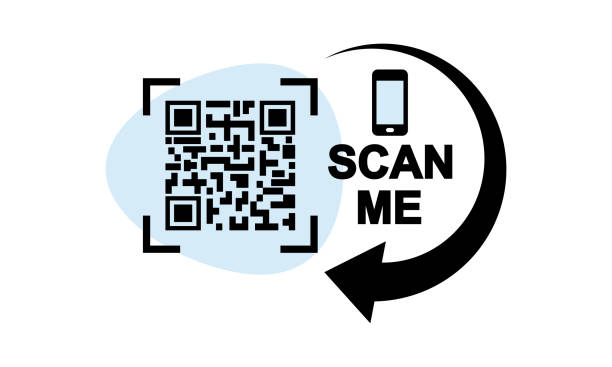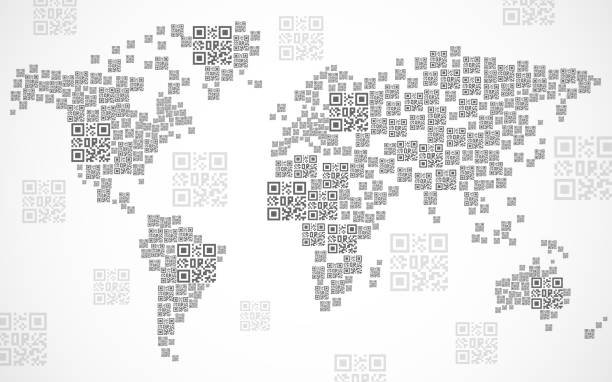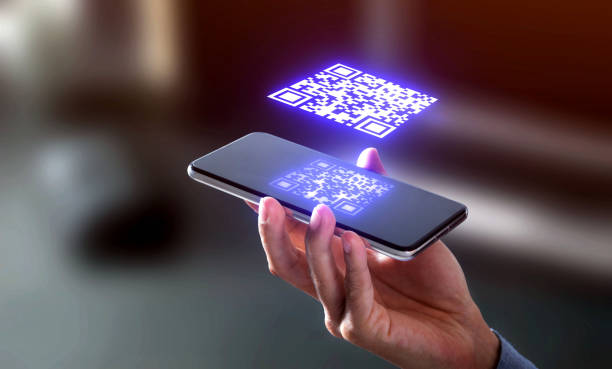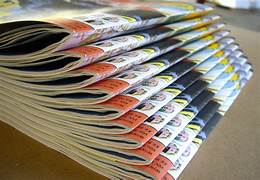
Denso Wave pioneered QR codes in 1994, fundamentally changing media communication. By transforming standard print into interactive digital platforms, QR codes provided a leap forward. They can store more data than traditional barcodes, making custom booklets immersive and information-rich. MVP Print excels in creating custom booklets tailored to the unique needs and visions of our customers, ensuring a perfect blend of quality, customization, and quick turnaround times.
MVP Print uses QR codes to bridge printed media with online content. This integration enriches the reading experience by offering direct access to videos, PDFs, and social media. It’s a powerful tool for companies, amplifying marketing efforts with interactive elements and easily shared information.
The versatility of QR codes in booklets is extraordinary. They can gather real-time product feedback, present fashion custom printed booklets, or announce new releases. This encourages customer engagement and future sales. It’s crucial to design QR codes that reflect the brand’s identity, blending seamlessly into the design.
Dynamic QR codes present even more benefits, such as advanced tracking and media-rich capabilities. They can be applied to various print media, including banners and business cards. By doing so, brands create a bridge between print and digital marketing, offering a unique experience.
Introduction to QR Codes in Custom Printed Booklets
QR code technology has transformed booklet printing, linking physical documents with the digital sphere effortlessly. Denso Wave introduced these codes in 1994. They significantly improve user experience by allowing instant digital access with a smartphone scan. The technology now harmonizes with both Apple and Android systems. For MVP Print clients, using QR codes in custom booklets can boost their marketing in ways unimaginable without it.
Integrating QR codes into booklets enables businesses to craft engaging experiences for their audience. Through these two-dimensional barcodes, customers can swiftly access a range of media. This includes direct browsing of digital portfolios, watching videos, or accessing unique online content, without the hassle of manual URL input. It’s a surefire strategy to elevate customer engagement.
While there are other technologies like Blippar and Snap Tag, QR codes stand as a pillar of trust for consumers. Marketing endeavors employing them, including flyers and brochures, have proven their value. This legacy underscores their efficiency and adaptability in multiple scenarios.
The efficacy of QR codes depends heavily on their presentation. Visibility, ease of scanning, and a minimum 300 dpi resolution are key. By pre-testing them for scanner readability and user experience, their impact can soar.
Aspect Printing pioneered in tech integration, offering a sophisticated QR code generator. This software exports high-quality SVG vector art. With this, businesses gain the ability to imbue their marketing collaterals with interactive QR codes seamlessly, ensuring a unified customer experience.
Smartphones have propelled QR codes beyond mere novel marketing tactics. They are now an integral part of modern campaigns. By leveraging QR codes, firms bridge the gap between their print and digital strategies effectively. Through this, they deepen client relationships, gather analytical data on user interactions, and expedite communication.
In a broader sense, QR codes present an affordable means to augment marketing collateral. They transform passive readers into actively engaged participants. This results in enhanced material impacts and fosters genuine interactions with the audience. MVP Print enhances this experience by offering efficient and convenient online booklet printing services, ensuring clients can easily integrate QR codes into their booklets, elevating their marketing strategies.
Benefits of Integrating QR Codes into Custom Printed Booklets

Adding QR codes to custom printed booklets has numerous benefits. It enhances reader engagement and offers in-depth data on how users interact. This approach is innovative in several ways. By integrating QR codes when printing booklets, MVP Print ensures your projects benefit from both our design expertise and competitive pricing, inviting you to get started with our top-notch printing services.
Enhanced Customer Engagement
QR codes excel at making passive readers active. They turn booklets into an interactive adventure. For example, “The Usborne Science Encyclopedia” by Usborne Publishing features 180 QR codes that link readers to extra content, like audiobooks and quizzes. Such integration can increase engagement by up to 50%, revolutionizing the reading journey.
Real-time Analytics and Tracking
QR codes are adept at collecting detailed booklet analytics. They provide instant data on user interactions with the help of tools like Bitly QR Codes. This allows businesses to fine-tune their marketing based on real-time engagement. Such insights not only increase the effectiveness of marketing campaigns but also reveal user preferences and behaviors.
Cost-Effective Marketing
QR codes save on marketing costs without sacrificing quality. They replace a significant portion of printed material with digital links. This method cuts printing costs by 25%. Furthermore, it reduces paper usage by 20%, demonstrating a commitment to eco-friendly publishing. The result is a more engaging and sustainable marketing strategy.
By leveraging QR codes, the efficiency and appeal of printed booklets are substantially enhanced. They bring a contemporary edge to traditional media, elevating the reading experience. This modern approach attracts and retains audience attention with ease.
Benefit Impact Enhanced Engagement Up to 50% increase in user engagement Marketing Effectiveness 30% higher engagement rate compared to traditional booklets Data Collection Real-time analytics on user interactions Cost Savings Up to 25% reduction in printing costs Environmental Impact 20% reduction in paper usage Reader Interaction 35% higher reader interaction rate
Designing Effective QR Codes for Custom Printed Booklets
The design of QR codes in booklets is crucial for user engagement and functionality. QR codes, whether static or dynamic, demand careful consideration. They should not only serve their purpose but also complement the aesthetics of the booklet. At MVP Print, we focus on creating QR codes that are both visually appealing and practical for our clients.
Static vs. Dynamic QR Codes
The difference between static and dynamic QR codes is important to grasp. Static QR codes contain fixed information and do not change over time. They suit uses like sharing contact details. Dynamic QR codes, however, can be updated and offer insights into user interactions. For marketing, their versatility and data tracking capabilities make them a superior choice.
Customising QR Code Design for Saddle Stitched Booklets
Custom design of QR codes helps in brand identification and enhances the user experience. Including a logo, selecting the right colours, and ensuring easy scanning are critical. Well-designed QR codes not only look good but also facilitate better engagement with the booklet. This is especially important when trying to integrate them seamlessly into the overall design.
It’s important to remember, Saddle Stitched books need to have Art supplied as a PDF file for print. The page count needs to be in multiples of fours, including four cover pages (two for the outside cover, and two for the inside cover). Often, when designing a book, it is necessary to leave blank pages somewhere in the book to make it up to multiples of four… most commonly this is done by leaving the inside covers with our print. So with Saddle Stitching, it is very important – from the outset – that the print file is in multiples of four, and as always, in PDF format for an optimum result.
Ensuring Scannability and Contrast

To make QR codes effective, it’s essential they are scannable and stand out. High contrast between the QR code and the background is crucial for scanning reliability. Moreover, the right size and placement within the booklet ensure they catch the eye. MVP Print uses top-tier printing methods to guarantee QR code readability and functionality.
Within education, QR codes can provide students with quick access to extra learning resources. For authors and publishers, these codes offer opportunities to share additional content, such as interviews or research, at no extra printing cost. The value of dynamic QR codes is further highlighted by the insights they offer into user behaviour, aiding content creators in understanding and engaging their readers better.
By leveraging digital content through QR codes, the publishing industry can drive sustainability by reducing physical waste and reprint costs. This approach to book enhancement not only benefits the environment but also enriches the reading experience for consumers.
Feature Static QR Codes Dynamic QR Codes Editing Capability No Yes Data Analytics No Yes Cost Fixed Variable Use Cases Basic Information Marketing, Tracking
How to Place QR Codes in Custom Printed Booklets for Maximum Impact
QR codes in custom booklets can greatly enhance the reader’s experience. Placing them in visible, easily accessible areas is vital for interaction. This approach aids in flawless integration with the booklet’s design, making scanning effortless. Considering how many pages a booklet has is crucial when integrating QR codes to ensure they complement the booklet’s content without overwhelming it.
Strategically placing QR codes on the booklet’s covers is a smart move. This way, they catch the reader’s eye immediately, ensuring they’re used. QR codes at chapter beginnings and on title pages, besides, draw readers in. They spark curiosity about the digital add-ons, promoting further interaction.
In booklets with lots of educational content, QR codes on the margins serve well. They link to extra study aids, videos, or tests, enriching learning without cluttering the design. Dynamic QR codes can keep these links updated, offering fresh content without reprinting.
Tracking QR codes’ performance with analytics tools like those from QRCodeDynamic is key. These tools offer insights on scans, locations, and devices, helping to tweak strategies. This optimization aids in a more engaging and satisfying reading experience.
QR codes provide a cost-effective method to make booklets more interactive. Placing them thoughtfully within the layout, be it on covers, titles, or margins, is crucial for success. Such strategies not only improve the reader’s journey but also boost the codes’ efficiency in bridging the gap between print and digital content.
Interactive Print Ads
Interactive print ads take us from plain pages to immersive digital journeys. These ads combine old-school printing with hi-tech like QR codes. This mix turns a simple scan into a portal, offering viewers anything from special deals to vivid brand stories, linking them to exciting online destinations. MVP Print elevates this experience through our booklet printing services, enabling brands to create interactive print ads that captivate and engage, seamlessly connecting the physical and digital worlds.
Turning Static Pages into Interactive Experiences
Adding QR codes to print materials changes audience interaction drastically. Instead of static text, users get to explore a blend of paper and digital. Imagine a travel brochure that launches virtual tours. This marrying of static and dynamic content elevates the reader’s experience, making it truly unforgettable.
Case Studies and Examples
MVP Print showcases QR code success stories, transforming how customers engage. In a retail case study, QR codes in a catalogue unlocked online-only deals, boosting visits and sales. An automotive booklet used these codes to offer detailed car insights, delivering both a tactile and informational delight, enriching the buying process.
Here’s a digest of booklet printing, showing customizable features like order quantities and sizes:
Feature Details Minimum Order Quantity (MOQ) 100 units Size Range 3.74″ to 11.69″ in width or height Page Count Multiple of 4 Binding Options Saddle stitch (up to 48 pages), perfect binding (more pages or heavier paper) Shipping Weight Estimation Provided during order process Pricing Factors Size, paper type, finishes, binding style Price Range 100pcs to 10,000pcs Additional Services Competitive pricing, fast turnaround, free training for wholesalers and marketers Standard Commercial Size 8.5″ x 11″ (210mm x 297mm in Europe)
QR codes in print media prove the power of blending the tactile with the tech-savvy. Through this mix, businesses unlock new avenues, marrying traditional marketing with the digital age. They aim to engage their audience in ways never seen before.
Direct Mail Campaigns with Custom Printed Booklets
Direct mail campaigns are seeing renewed success through QR codes. This combination links offline and online worlds, enhancing customer experiences. By integrating QR codes into mailers, businesses can smoothly draw their audience from print materials to the web.
Connecting Offline with Online
Australia Post reports over 90 percent engagement with direct mail in the land down under. The addition of QR codes makes this engagement even richer. It allows for a transition from the physical mail to the digital world, significantly enhancing customer involvement. This not only captivates the recipient but also provides clear data on how well each campaign is performing.
When it comes to costs, QR codes in mailers are often a more affordable option than pure digital marketing. This is especially true when you consider costs per 1000 people reached (CPM). Add environmentally friendly printing options to the mix, and you have a fast, cost-effective, and green marketing approach.
Success Stories from Various Industries
There are plenty of success stories that prove the power of QR codes in direct mail. A recent example is the story of a retail company whose dynamic QR campaigns led to a boost in both online and in-store activity. Personalisation is key. It increases the chances of getting a positive response.
MBE, with its focus on expert design and mailing list management, has also shown how powerful direct mail can be. By teaming up with a wide courier network, they not only make mailing more cost-efficient but also ensure it’s effective. Such examples highlight the broad and consistent success of QR code marketing across industries.
Here’s a look at the various paper types available for direct mail booklets and brochures:
Paper Type Features 80 gsm Lightweight, economical 100 gsm Sturdier feel, cost-effective 120 gsm Durable, general use 150 gsm Premium brochures 200 gsm Professional cover pages 250 gsm and above Premium covers
Printing is not only speedy, often within 24 hours, but also flexible. Same-day options are available for urgent needs. By adding QR codes to their print media, companies bridge the gap between physical and digital marketing. This approach puts engaging content directly in the hands of their audience.
Event Engagement with Booklet QR Codes

QR codes have transformed how we experience events by offering instant access to extra content. Including them in program booklets can boost engagement and interaction among attendees.
Utilising QR Codes in Event Programmes
QR codes in event programmes provide numerous benefits for organisers. Attendees can scan codes to access schedules, speaker bios, and interactive features. This is all managed easily with tools like QRCodeDynamic, which streamline the process of keeping information current. Dynamic QR codes enable effortless updates to content, maintaining a smooth user experience.
These codes also link to digital content, like live sessions, tours, and special offers. Introducing digital features enriches the event, merging the physical and digital worlds. For example, Usborne Publishing’s “The Usborne Science Encyclopedia” includes 180 QR codes, demonstrating how they blend physical and digital content.
Enhancing Attendee Experience
The use of QR codes significantly improves the event experience. After employing QR code badges for check-in, events saw a 30% rise in attendance. Moreover, 86% found them helpful for networking, leading to efficient information sharing. Event planners enjoyed a 25% decrease in check-in times, which streamlined their operations.
QR code badges offer personalisation, with 73% of attendees valuing the tailored information. This personal touch boosts satisfaction by 40%, offering real-time feedback and easy information access. Presenters like Molly Baz use QR codes for interactive demos in their books, illustrating the power of these tools.
Beyond enhancing the experience, QR codes offer insights into attendee engagement and preferences. This data helps refine future events and marketing plans. Through these benefits, QR codes have revolutionised event marketing, increasing attendee engagement by 68%.
Benefit Impact Increased Attendance 30% rise post QR code implementation Networking Efficiency 86% attendees found QR codes efficient Check-in Time Reduction 25% decrease with QR code badges Improved Event Security 95% of organisers noted improvements Enhanced Attendee Satisfaction 40% increase with QR codes
Transforming Business Cards and Company Profiles
MVP Print is changing how we view business cards and company profiles. They’re adding features like multifaceted cards and QR codes for a professional touch. These changes make networking richer and more informative.
Adding Depth to Business Profiles
MVP Print uses QR codes to take business profiles to the next level. With digital portfolios just a scan away, profiles gain depth and richness. This combination of print and digital showcases a company’s full potential, appealing to their target audience.
Creating Multifaceted Business Cards
The game changes with QR codes on business cards. These new-age cards are more than just contacts. By scanning, others can access your digital portfolio or business details. It boosts networking effectiveness and shows how tech-savvy the company is.
Custom Printed Booklets: Examples and Success Stories
Trade books are a significant part of book publishing, appealing more broadly than academic works. Blurb’s trade book sizes, including 5×8 in (13×20 cm), 6×9 in (15×23 cm), and 8×10 in (20×25 cm), are perfect for various genres. They are great for adding QR codes, enhancing user experiences in fiction, nonfiction, memoirs, and photo books.
Leveraging QR codes can significantly boost the effectiveness of custom booklets. Little Rock Printing™ provides various booklet sizes, such as Standard, Oversize, and Half-Size, from $5.93 onwards. They are printed in 1-5 business days. This affordable approach allows businesses to blend print with digital, creating dynamic products. MVP Print is committed to offering cheap booklet printing options that ensure affordability without compromising on quality.
Real-life Applications
QR codes are changing the game in product packaging. Brands like Nike and Uniqlo use QR codes on their booklets to offer things like recipes or how-to videos. This approach increases customer satisfaction and interaction, showing the real-life impact of QR codes.
Business and Corporate Use Cases
Corporate QR strategies are also gaining traction, with companies like Deloitte and PwC adopting them in their reports. Through these QR codes, stakeholders access detailed financials and engaging videos instantly. This not only reduces costs but also deepens engagement and transparency.
Events also benefit greatly from booklet-QR integrations. Conference booklets with QR codes can guide participants to schedules or speaker bios. Oracle and Adobe have successfully enhanced their events with this approach, improving the overall participant experience.
These examples highlight the value of QR codes in booklets for both business and personal activities. As technology advances, we can expect even more groundbreaking applications in various sectors.
Important Considerations and Binding Options for Best Practices
Making QR codes work well in booklets demands sharp attention to key aspects. It’s vital to stick to the best practices. This ensures your QR codes function at their best, making user engagement soar.
QR Code Sizing and Placement
Choosing the right spot for a QR code is about making it visible and easy to scan. Standard advice is to keep the QR code big enough for easy scanning at a 10:1 distance-to-size ratio. For example, if it’s scanned from 10 cm away, it should be minimally 1 cm in size.
This is important for a smooth experience. The code shouldn’t be placed in areas that are too curved or folded, as it might get distorted.
It’s also key to follow QR code standards, like leaving space around the code. Known as the quiet zone, this is a region around the QR code that should be kept empty. This helps with scanning. A good spot for the code in booklets is where it’s easily noticed, such as the inside front cover or near calls to action.
Optimising QR Codes for Mobile Devices
Most users will scan QR codes with their phones, making cellphone optimization crucial. This means designing the QR code for mobile screens and ensuring high contrast. Using a light background and a dark QR code makes it more visible.
Moreover, what the QR code links to should also be mobile-friendly. It’s essential that the linked content loads quickly and looks good on a phone. This meets user expectations and improves their experience, aligning with industry standards for QR code use.
Consideration Details Industry Standard Sizing Maintain a 10:1 distance-to-size ratio Minimum 1×1 cm Resolution High resolution for print (150-300 DPI) 150-300 DPI Placement High-visibility areas, avoiding distortions Inside cover, by call-to-action sections Optimisation for Mobile High contrast, mobile-friendly design Light background, dark QR code
Conclusion
In today’s fusion of digital advancements with ancient techniques of printing, the use of QR codes in custom printed booklets has opened thrilling new doors. This innovative QR code booklet strategy connects the worlds of traditional print and online activity. It provides a fresh way to interest audiences, making marketing both modern and impactful. Leading the way in this field, MVP Print is enabling businesses to enrich their communication with consumers.
The incorporating of booklet QR integration points to the future of engaging with media. By enabling direct interaction with content and offering analysis, QR codes transform how audiences and brands connect. Such integration ensures that physical booklets stay pertinent and persuasive in our digital world, maintaining their attractiveness.
For more than twenty years, print-on-demand has reshaped this arena, and the introduction of QR codes marks a new chapter. Featuring the ongoing balance between digital and offset methods, MVP Print has perfected a method. This method produces booklets that not only look good, but also encourage hands-on engagement.
The horizon for QR code technology’s role in printed content is vast. By utilising these progressive methods, businesses stand to achieve profound consumer engagement. A creative application of QR codes, paired with top-notch printing and design, promises to redefine marketing landscapes. This approach is poised to steer advertising, branding, and media dynamics well into the future.







